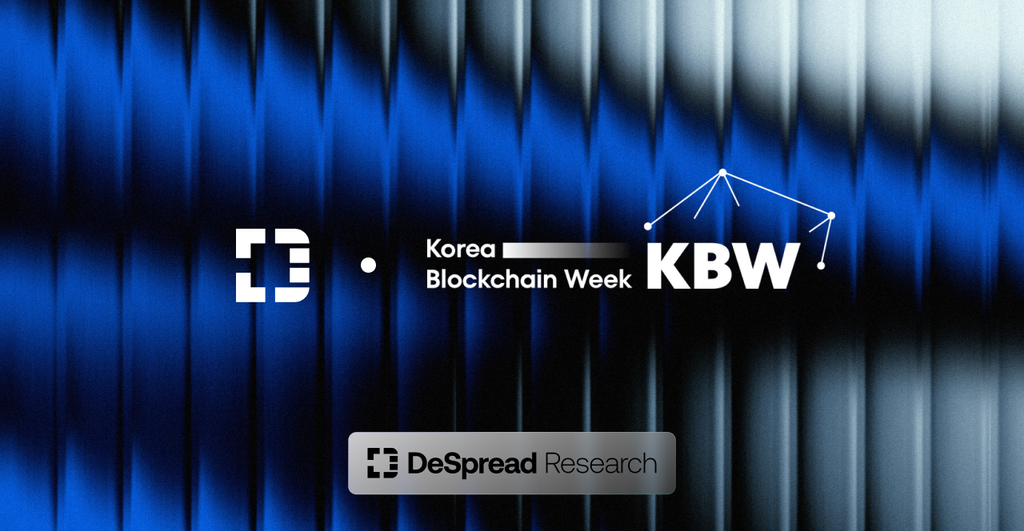
KBW2024 Participation Report — Exploring Global Blockchain Trends from Korea
Blockchain Industry Trends and Development Directions as Seen Through KBW2024

1. Introduction
KBW (Korea Blockchain Week) is a global blockchain and Web3 festival jointly hosted by Factblock, a blockchain consulting firm, and Hashed, a Korean crypto venture capital. It has been held annually in Seoul for seven years since 2018, becoming a large-scale regular event.
Korea accounts for 10% of the global virtual asset market trading volume, making it an essential country for blockchain/Web3 projects to consider when promoting their projects. As a result, the annual KBW event has become an essential annual event for numerous overseas project teams and industry stakeholders.
This year's 'KBW2024: IMPACT' conference was held for two days from September 3rd to September 4th at the Grand Walkerhill Hotel in Seoul. Sui and Movement, Layer 1 networks, and BRV Capital, a venture capital firm, participated as official conference partners. Bitgo, a virtual asset custody and security service provider, and Hana Financial Group participated as official institutional partners.
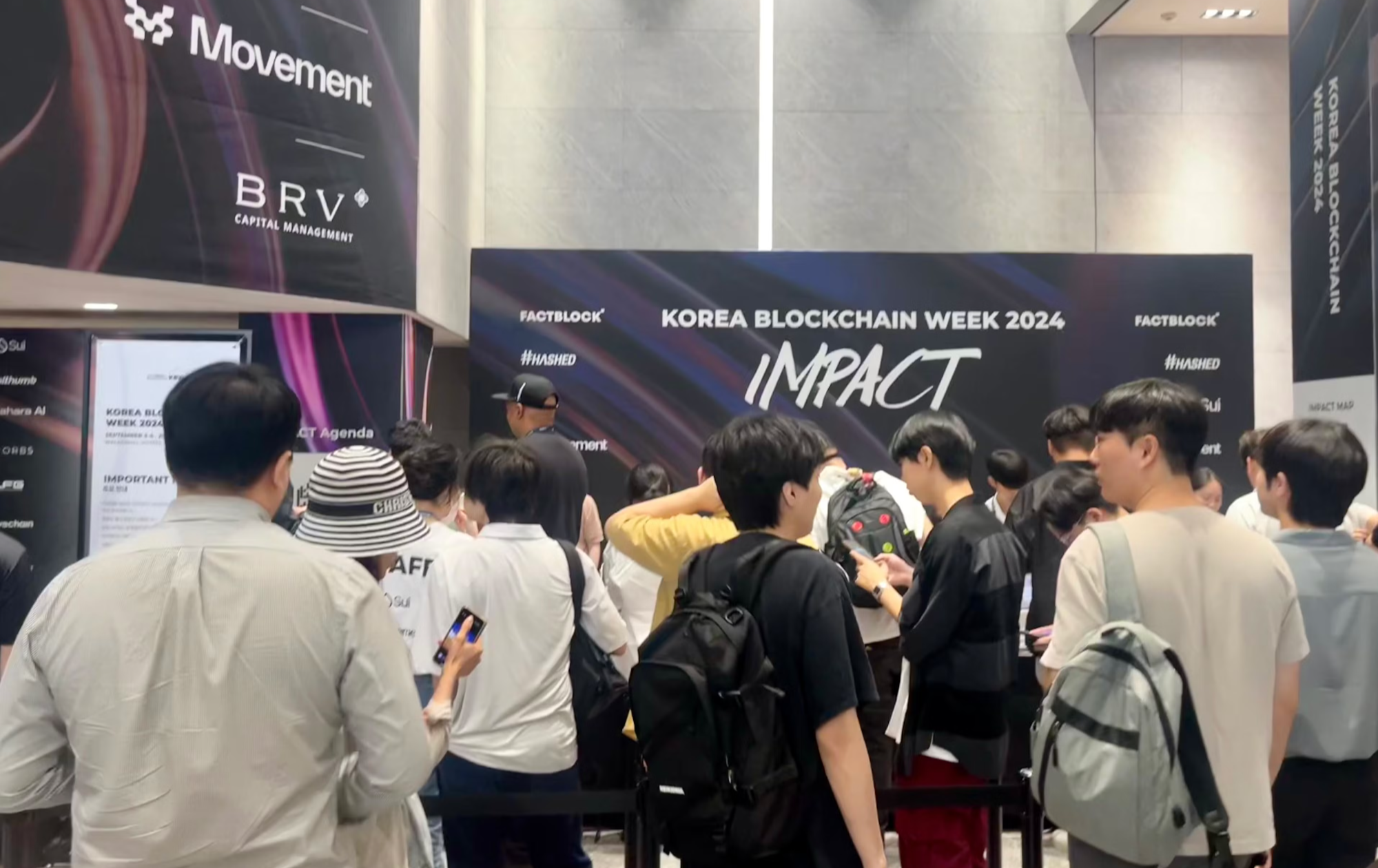
According to FactBlock, the organizer, about 17,000 people visited the event, more than double the number of visitors to KBW2023 held last year. The proportion of foreign visitors was 35%, 5% lower than last year. This allowed us to observe that the Korean public's interest in virtual assets has also increased due to the entry of traditional financial institutions into the market and the upward trend in the virtual asset market following the approval of Bitcoin spot ETFs this year.
By participating in the IMPACT main event held over two days, I was able to observe and analyze the sectors that the industry is currently focusing on and feel the increased public interest in the crypto industry. In addition, I was able to share perspectives on industry trends with industry experts I met while participating in 340 individual official side events held for about a week from September 1st to 7th, including the dates of the main event.
In this article, I'd like to look at the trends and prospects of the virtual asset industry through KBW2024 and share my thoughts on participating in this year's KBW main event and side events.
2. KBW2024: IMPACT Recap
2.1. Speech Session Analysis
At KBW2024's main event, IMPACT, a total of 129 speeches were delivered over two days, excluding the opening address by Jeon Seonik, CEO of Factblock, and the stage performance by tripleS, an idol group created by Modhaus, a subsidiary of Hashed.
These speeches were conducted simultaneously on four stages (Institutional Stage, Forbes Web3 Stage, Sui Stage, Movement Stage), and the characteristics of each stage are as follows:
- Institutional Stage: Speeches mainly focused on topics closely related to traditional institutions, such as Web2 institutions entering Web3, government regulations on virtual assets, and RWA (Real World Asset)
- Forbes Web3 Stage: Mainly keynote speeches where key figures from specific blockchain/Web3 projects introduced their projects or discussed the prospects of the category their project belongs to
- Sui Stage, Movement Stage: Mainly panel talks and fireside chats where industry experts exchanged opinions on specific topics
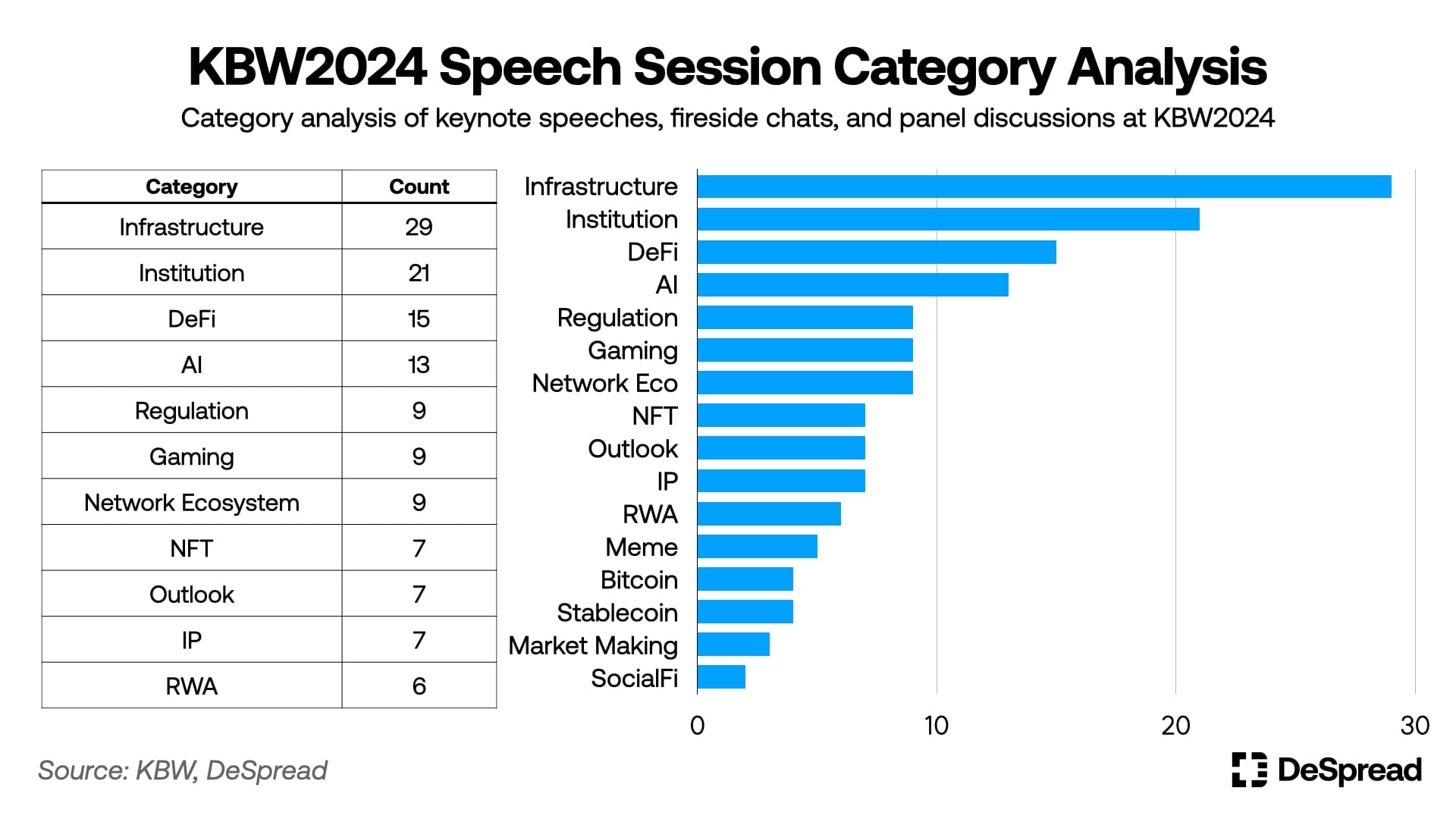
The above chart visualizes the areas that the blockchain/Web3 industry is currently focusing on by analyzing the categories of 129 speeches delivered at KBW2024. However, some speeches may belong to multiple categories, and categories with five or fewer occurrences have been truncated.
2.1.1. Blockchain Infrastructure
As various blockchain network teams and foundations participated in KBW2024's sponsorship and partnerships, discussions on improving each network's infrastructure environment and technological capabilities accounted for the largest proportion with 29 speeches.
Among these were discussions on solutions to the limitations of public blockchains that have been discussed previously, such as network scalability and privacy protection through Zero-Knowledge proofs. However, it was notable that speeches related to Non-EVM based infrastructure, centered around Sui and Movement, the official conference partners of KBW2024, as well as Solana and TON, were also actively conducted.
Moreover, discussions on the development of modular blockchain construction environments and the resulting intensification of multi-chain environments also appeared quite frequently.
[Speeches related to modular blockchains and multi-chain environments]
- Modularity in a Multi-Chain World
- Cross-Chain Communication: Arbitrum's Role in a Multi-Blockchain World
- Over Troubled Waters: Solving Crypto's Fragmented Liquidity Problem
- Understanding Data Availability
- Too Many Chains: Can Wallets Keep Up With Crypto's Product Cycle?
- Crypto's Future Depends on Interoperability
In the 'Understanding Data Availability' panel talk conducted by Jason Ye, co-founder of DeSpread, Arjun, the founder of Avail, explained about the increasing number of modular blockchains, saying, "Today's bicycles have a form where parts are produced in different factories and assembled." He described this as an inevitable phenomenon as the industry develops and modernizes.
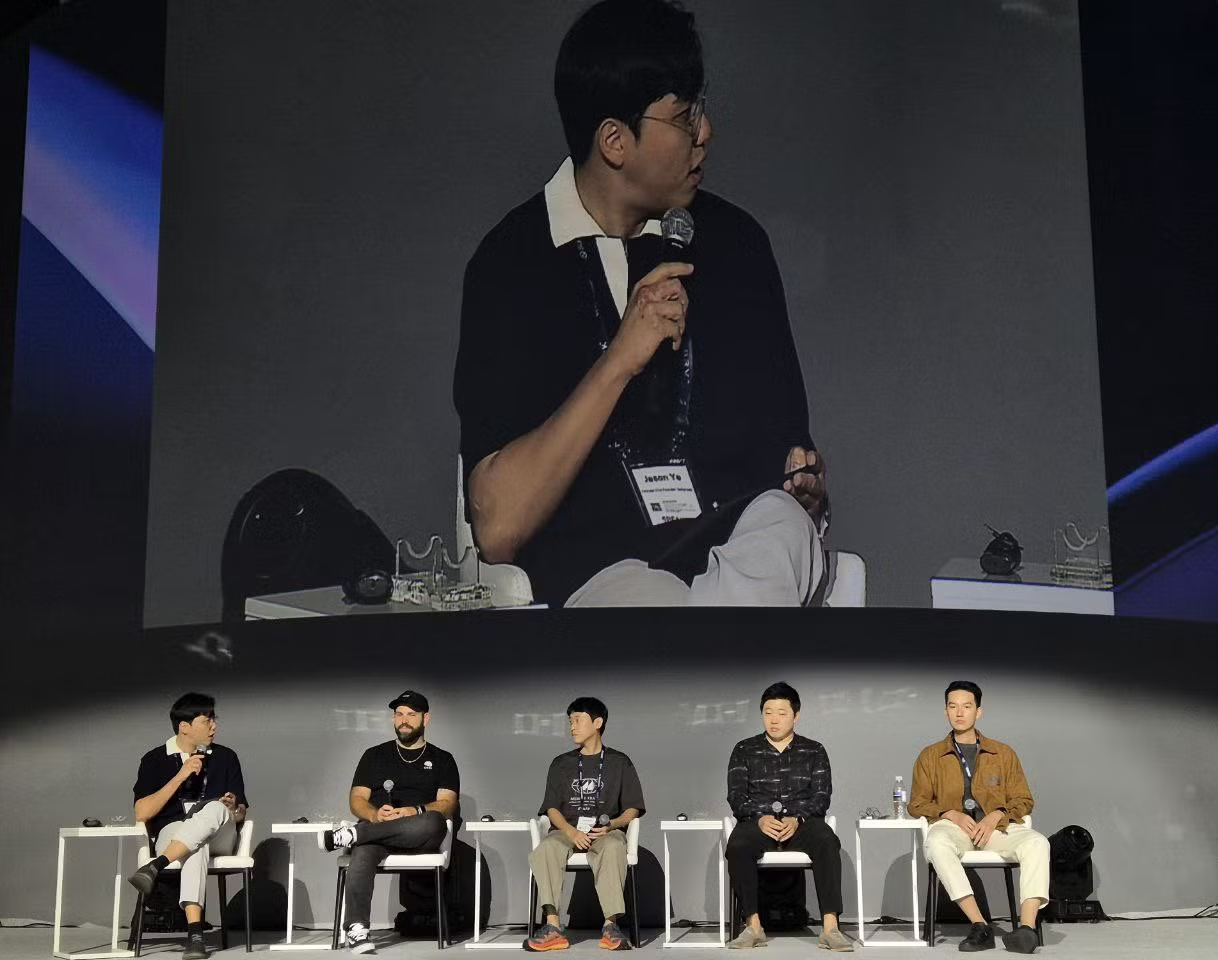
Arjun also mentioned that many private companies and governments are reluctant to use public blockchains, and predicted that cases of modular blockchain construction will increase in the future. As I listened to related sessions, I also thought that issues of liquidity fragmentation and deterioration of user experience due to the increase in modular blockchains would become more important issues in the future.
2.1.2. Institutional Participation in the Virtual Asset Market and Regulation
KBW2024 placed great emphasis on discussions about Web2 institutions' participation in the virtual asset market and government regulations, to the extent of setting up a separate Institutional Stage. Global speakers such as Mark T. Uyeda, Chief Officer of the U.S. Securities and Exchange Commission (SEC), Anna Yim, Chief Compliance Officer of Standard Chartered Bank, Yam Ki Chan, Vice President of Circle, a stablecoin issuer, and Henry Child, Ecosystem Head of Tether, participated in this stage. From Korea, personnel from major institutions such as Hana Financial Group, SK Telecom, and Mirae Asset gave presentations on related topics.
One session where we could hear expert opinions on Korean institutions' participation in the virtual asset market and the current status of regulations was 'Why Institutional Crypto Custody Is Booming in South Korea'. Cho Jin-seok, CEO of KODA, a Korean virtual asset custody company who participated in the session, pointed out that the current situation of the Korean blockchain industry is in a poor environment due to 1) the absence of an environment for corporate investment in virtual assets, and 2) the absence of industry promotion-related parts in the Virtual Asset User Protection Act. However, CEO Cho predicted that related systems will soon be prepared, leading to changes in the market, and that the role of virtual asset custody business in Korea will expand as corporate investment in virtual assets becomes possible.
Also, in the speeches under the 'Institutional Perspectives' theme, panel talks were held where institutions and blockchain-based project companies from Hong Kong, Japan, and Southeast Asia introduced the current status of the virtual asset market in each region.
2.1.3. DeFi
While discussions on Non-EVM based infrastructure dominated in the infrastructure category, in the DeFi category, the participation of founders of major EVM-based protocols in speeches was notable. Each founder took time to introduce their protocol and share their vision for the future through fireside chats.
[Fireside chats with founders of EVM-based DeFi protocols]
- Fireside With Aave's Stani Kulechov and Sky's Rune Christensen
- Fireside With Uniswap's Hayden Adams
- The Killer Application of Crypto: Money (with Guy Young, founder of Ethena)
Particularly in the fireside chat with Stani Kulechov, founder of Aave, and Rune Christensen, co-founder of Sky (formerly MakerDAO), Rune Christensen emphasized the need for cooperation rather than competition to attract liquidity in the current DeFi ecosystem, and introduced a collaborative product between Aave and Sky.
In addition, in the DeFi category, discussions on DeFi in the Bitcoin ecosystem were also actively held, in line with the recent trend of increasing DeFi protocols utilizing Bitcoin, such as Bitcoin staking and DeFi protocols based on Bitcoin network layer 2.
2.1.4. AI
At KBW2024, various speech sessions were held on the intersection of AI and blockchain, and ways to use blockchain as infrastructure in areas that are becoming more important with the development of the AI industry.
Vitalik Buterin, the founder of Ethereum, also gave an AI-related video speech at this event titled 'Ethereum and AI: Synergies and Potential Applications'.
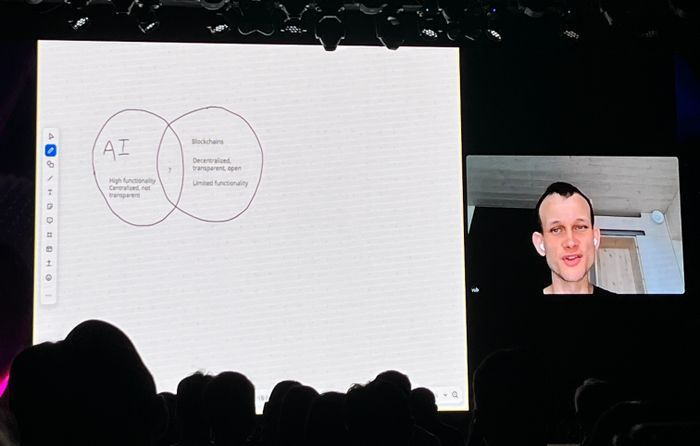
In this speech, Vitalik Buterin explained the points where AI and blockchain can be linked in four categories as follows:
- AI as a player: Utilizing AI as a player in blockchain-based systems (e.g., virtual asset management, prediction market betting)
- AI as an interface: Utilizing AI as an intermediary between users and blockchain and blockchain-based applications (e.g., scam detection, predicting and explaining transaction results)
- AI as a rule: Utilizing AI as an on-chain decision-maker such as smart contract algorithms, DAOs
- AI as a objective: Building and running blockchains for AI (e.g., decentralized AI)
Vitalik emphasized that 'AI as a player' is the most feasible area. He also suggested that if this area is advanced to form prediction markets in micro areas, it would be possible to build systems that guarantee the accuracy of specific external data needed by a small number of users or quickly evaluate the accuracy of rumors spreading through social media.
In addition, at this event, there were active discussions on ways to solve data ownership and intellectual property infringement issues that are being highlighted by AI development using blockchain. Even in speeches on topics not directly related to AI, mentions of AI frequently appeared, and through this, it was possible to feel that AI is exerting a wide-ranging influence on the entire blockchain industry.
2.2. Booth Analysis
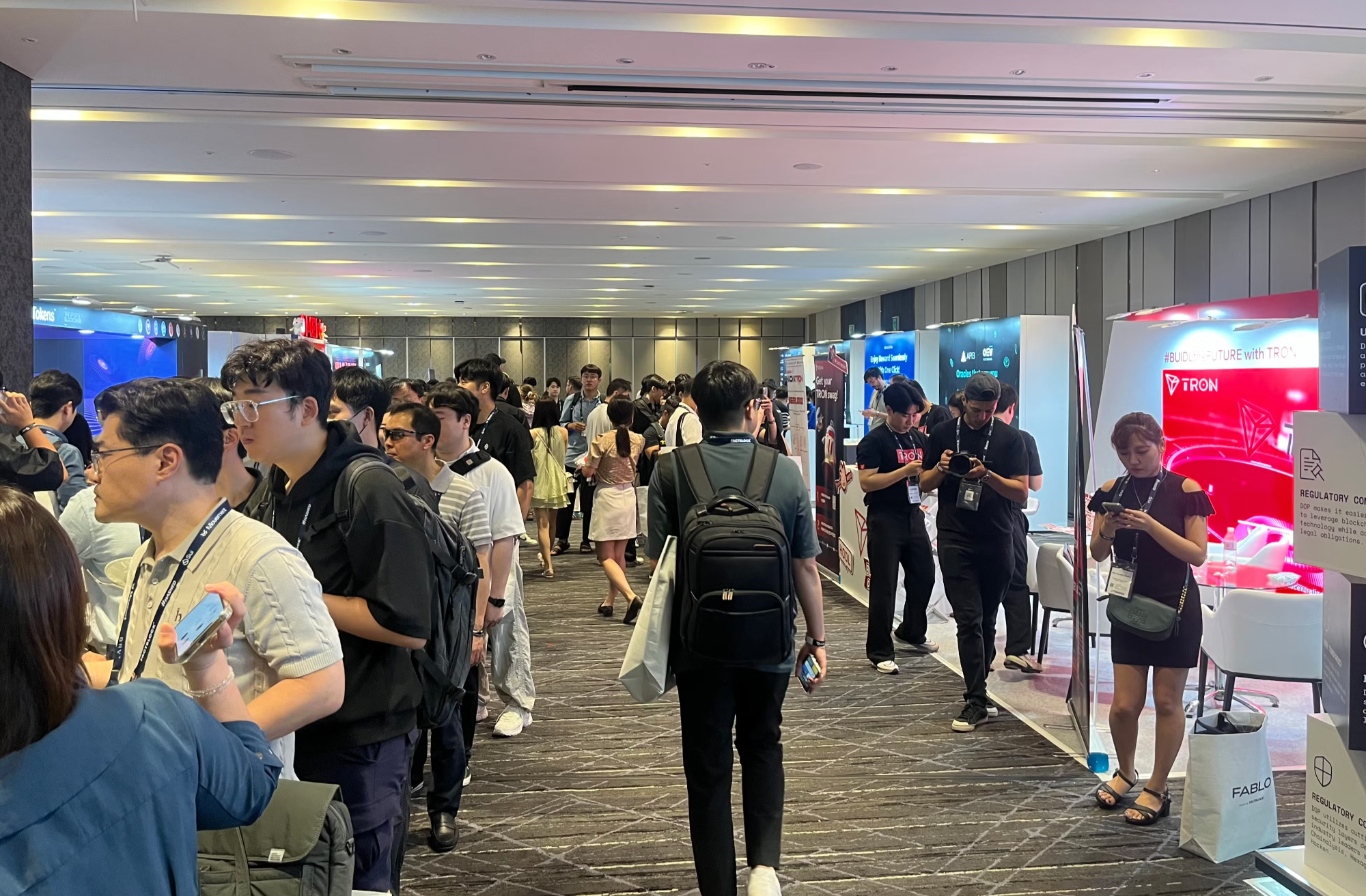
At KBW2024, in addition to the four main stages, 61 sponsor and partner booths were operated. Participants could visit each booth to ask questions about the project and receive the project's goods through various activities.
I conducted a category analysis of the representative characteristics of each booth operator at KBW2024, and to prevent excessive category fragmentation, some categories were integrated as follows:
Community: Education, NFT, Meme related
Middleware: API, Oracle, etc.
B2B Service: Consulting, Marketing, Market Making, etc.
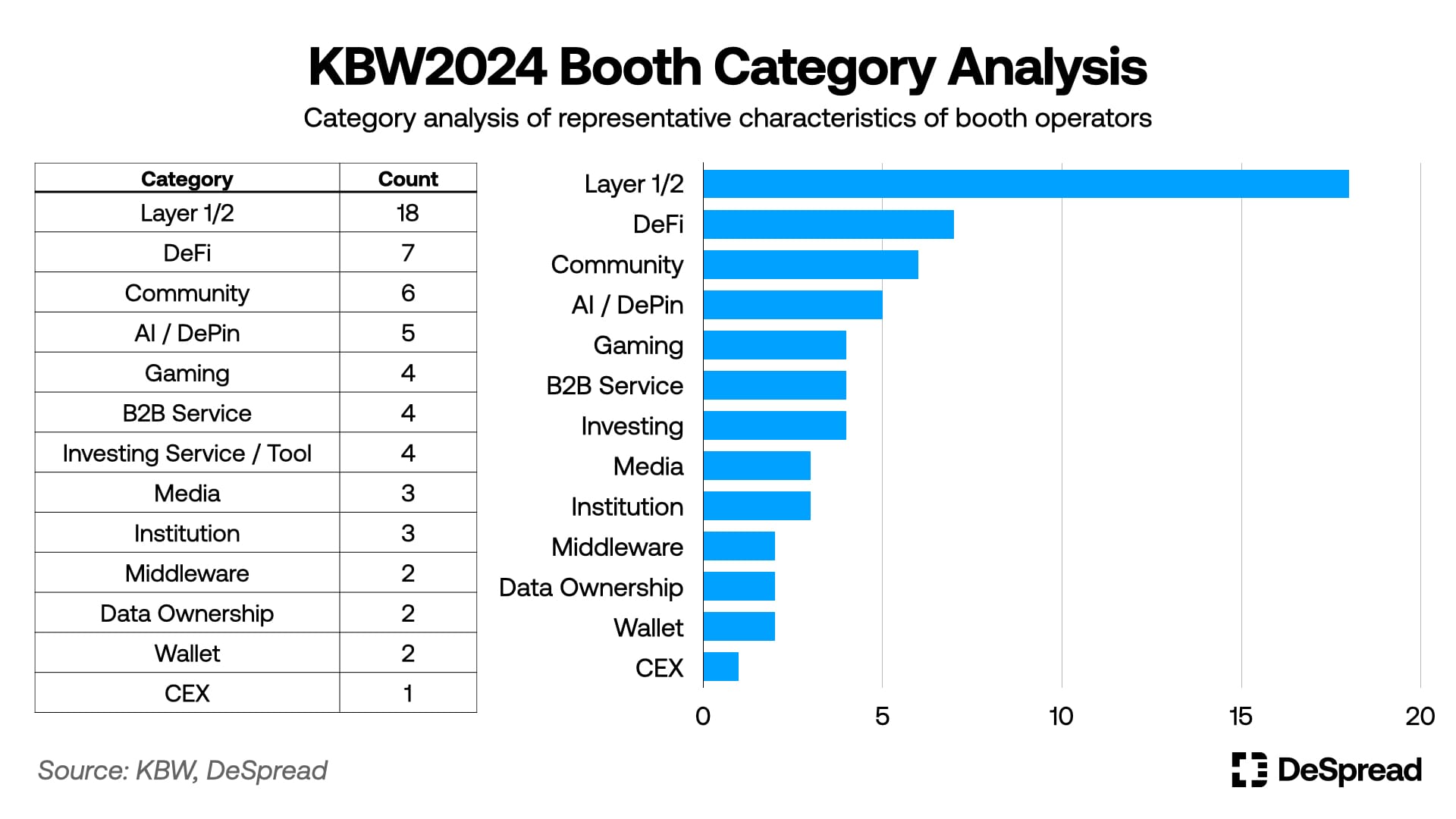
Among the booth operators, Layer 1 and Layer 2 were the most numerous with 18, followed by DeFi protocols. While participating in the event, I met many general participants, but I felt that there wasn't much content for general participants to enjoy as the speech topics and booth contents mainly focused on blockchain infrastructure and technology that required an understanding of the industry.
From this perspective, gaming and meme-related projects that expressed their projects intuitively through experiential events and goods at their booths were personally impressive.
2.2.1. Gaming
There were a total of four gaming-related booths operated at this event, with the Starknet Foundation, Futureverse, The Root Network, and Seraph operating booths in the Starknet zone. At the booths, visitors could directly experience the game services provided by each entity.
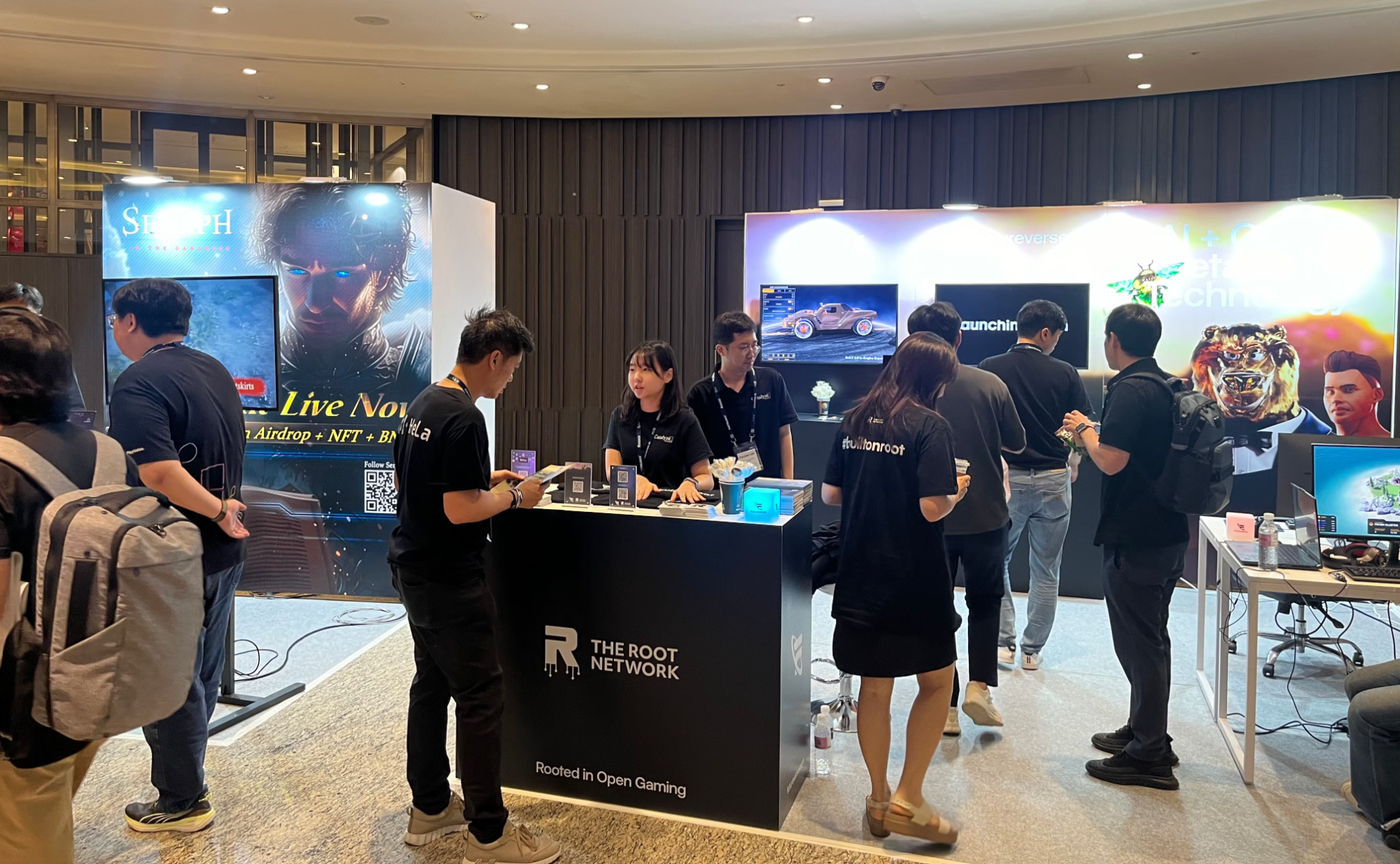
In addition, at the booth of Sui, the main sponsor of the KBW2024 event, teams developing games such as Xociety, Pebble City, and Darktimes, which have partnerships with Sui, and an e-sports team named Team Liquid participated together, adding to the spectacle.
Along with these moves, Sui started pre-sales of portable game consoles that connect with the network starting from September 3rd, the first day of the event, and we could observe efforts to establish itself as a game-friendly blockchain through this event.
2.2.2. Meme
At this event, two types of meme coin projects, Shiba Inu and MEW (Cat in a dogs world), operated booths. In particular, MEW, a meme coin project based on the Solana network, held an event where they distributed goods such as tumblers, eco bags, hats, figures, and stickers made using MEW's IP to booth visitors through a lottery. It could be observed that many visitors flocked to MEW's booth to participate in this event during the two days of the event.
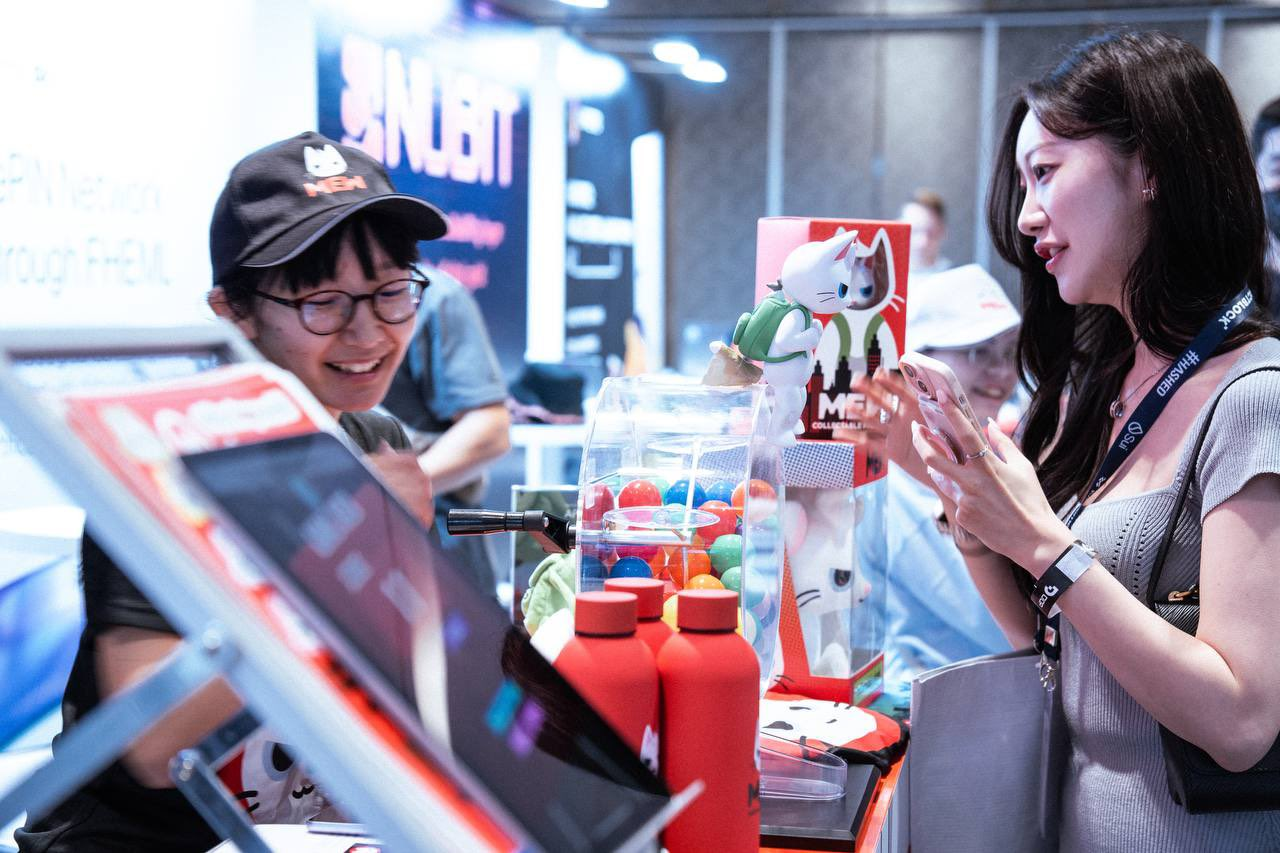
Until now, I had an image of meme coins as 'highly volatile investment products', but seeing many people lined up to receive MEW's goods, I could confirm another potential that meme coins can approach the public more familiarly in the form of IP.
2.3. Official Side Events
In addition to the IMPACT main event, 340 individual official side events were held at KBW2024. I analyzed the types of side events, and the results are as follows:
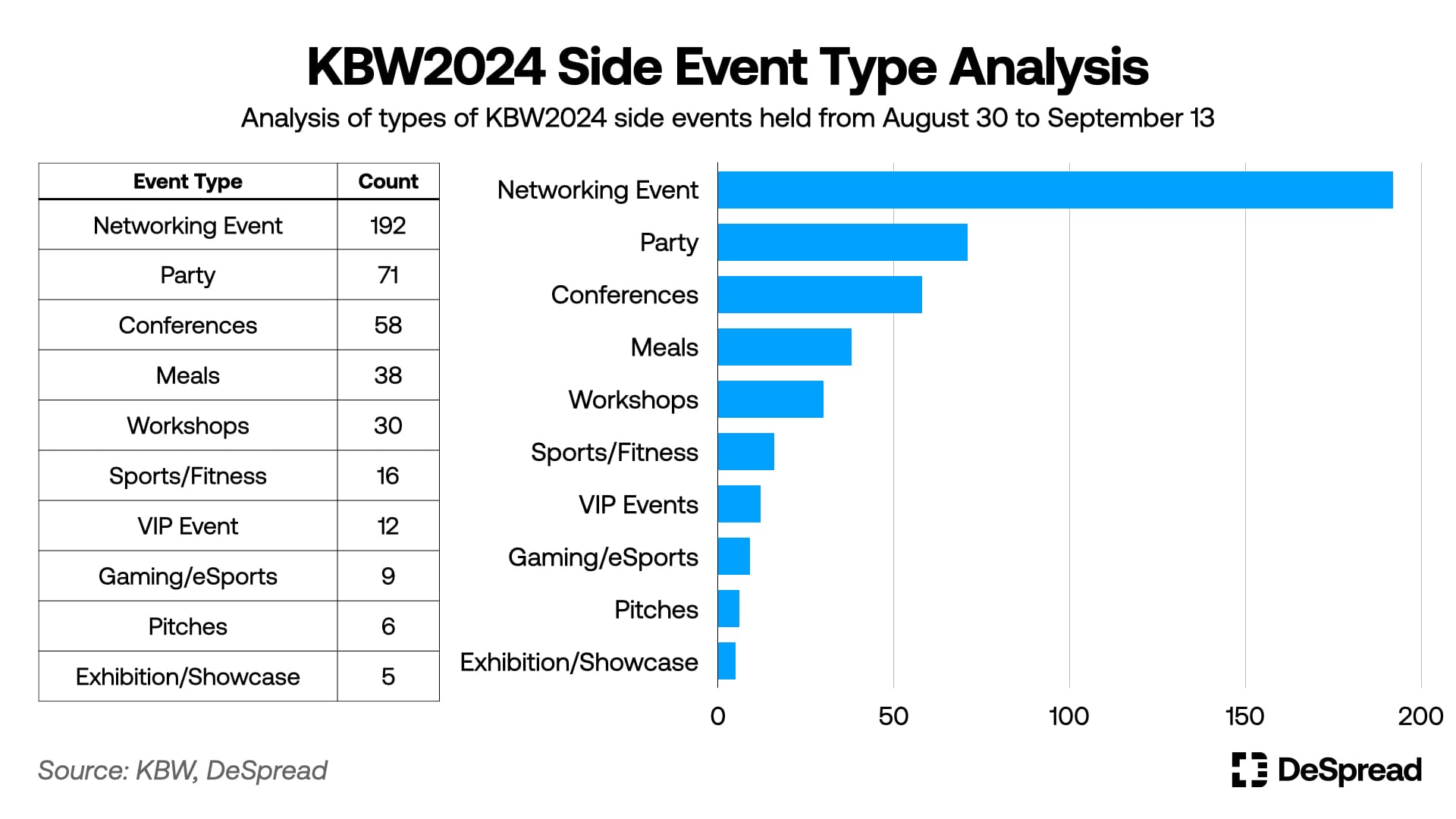
Given that the IMPACT main event ran from 9 AM to 6 PM, and the absence of an independent and spacious area for project users to communicate and network, it can be confirmed that most of the official side events were networking events and parties centered around individual projects, which accounted for the largest type of events.
Among these various types of side events, I was able to directly attend seven events that DeSpread hosted or participated in as a sponsor or partner, experiencing the atmosphere on-site. The side events that DeSpread participated in at KBW2024 are as follows:
- BTC Finance Revolution: Session and networking event related to Bitcoin-based DeFi ecosystem
- Berachain Meetup: Berachain Korean community networking event
- The Nakamoto Revolution: Session and networking event related to the Bitcoin ecosystem
- BTCON: Bitcoin ecosystem-related conference
- The Crypto Odyssey: VIP event attended by major Asian virtual asset media such as Crypto Times and TechFlow
- Beyond Boundaries: Session and networking event on multi-chain interoperability
- Casual Crypto Meetup: Community networking event by @JuhyukB, a crypto influencer affiliated with DeSpread
2.3.1. Berachain
Among the side events, the most memorable for me was the Berachain meetup. Smokey The Bera, co-founder of Berachain, and Primo, co-founder of LayerZero, participated in this event and conducted a speech session together. Several teams building projects in the Berachain ecosystem also attended the event, allowing us to hear introductions and explanations about each project directly.
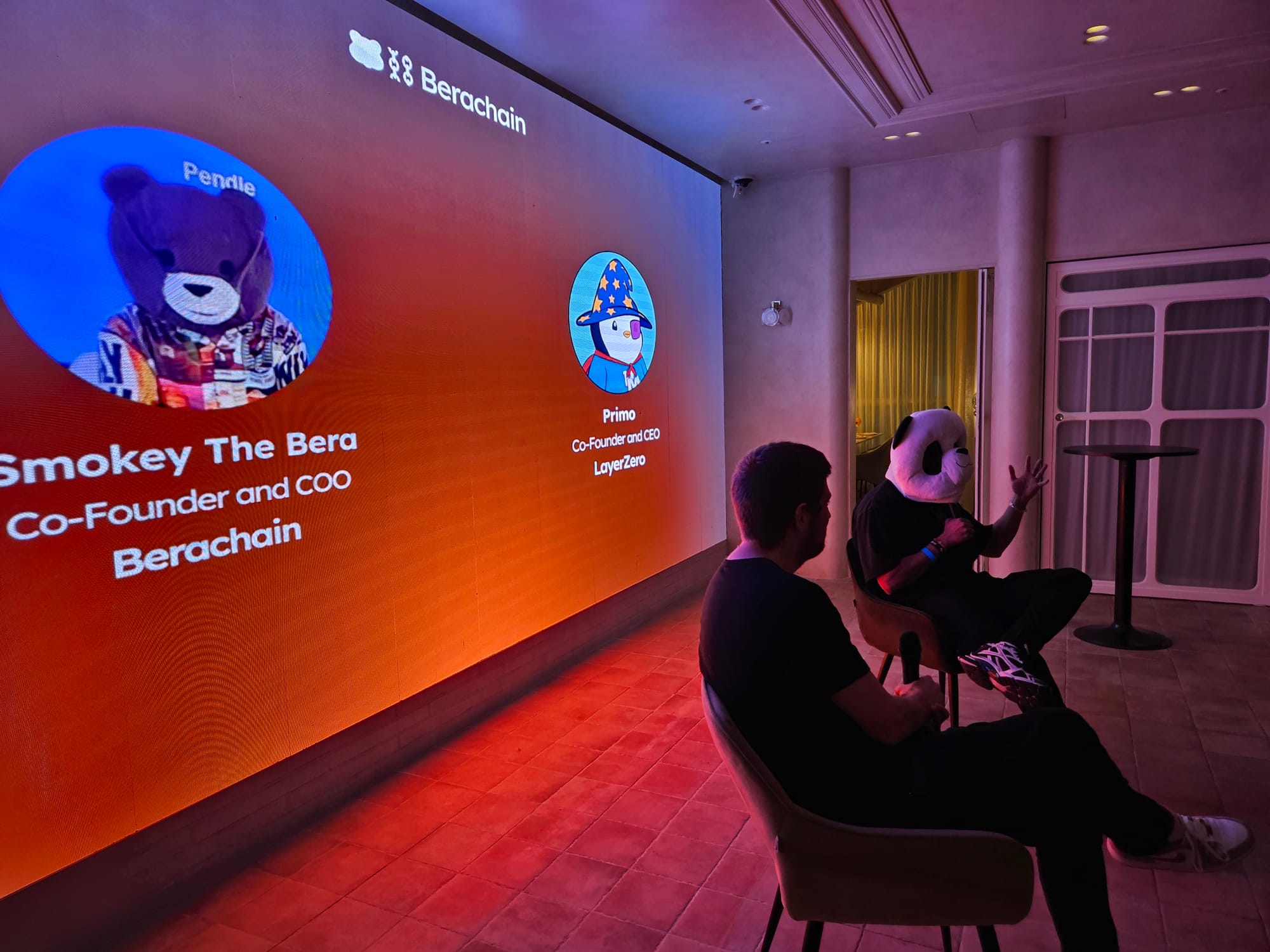
In a situation where 340 side events were held over a week, it was common for side events without special merit to show poor attendance. However, the Berachain meetup attracted so many visitors that entry had to be stopped due to space limitations.
While the fact that Berachain is approaching its mainnet launch might have been one of the reasons for the high event attendance, it seems that having a solid community based on NFT projects and starting network construction, along with the PoL (Proof of Liquidity) consensus mechanism that closely connects the network, projects, and liquidity providers, creating an environment where each entity needs to be more interested in each other, was reflected in the high event participation rate.
3. Thoughts on Participating in KBW2024
3.1. The Rising Bitcoin Ecosystem
Unlike other public blockchains such as Ethereum and Solana that can run smart contracts, Bitcoin, which only distributes BTC transfer history in a decentralized manner, has been mainly perceived as 'digital gold' that stores value.
However, attempts to use the Bitcoin network and BTC more broadly have been steady since 2018, starting with Rootstock and Stacks. Then, with the emergence of Ordinals, a Bitcoin-based token issuance protocol in 2023, Bitcoin is in the process of breaking away from its limited image as 'digital gold'.
Muneeb Ali, co-founder of Stacks, who participated in the side event 'The Nakamoto Revolution', said, "Bitcoin is ahead of any network in terms of institutional adoption, brand awareness, and global user understanding." He predicted that by using Bitcoin-based L2, we could attract many users and succeed in mainstreaming blockchain with these advantages and an improved network environment.
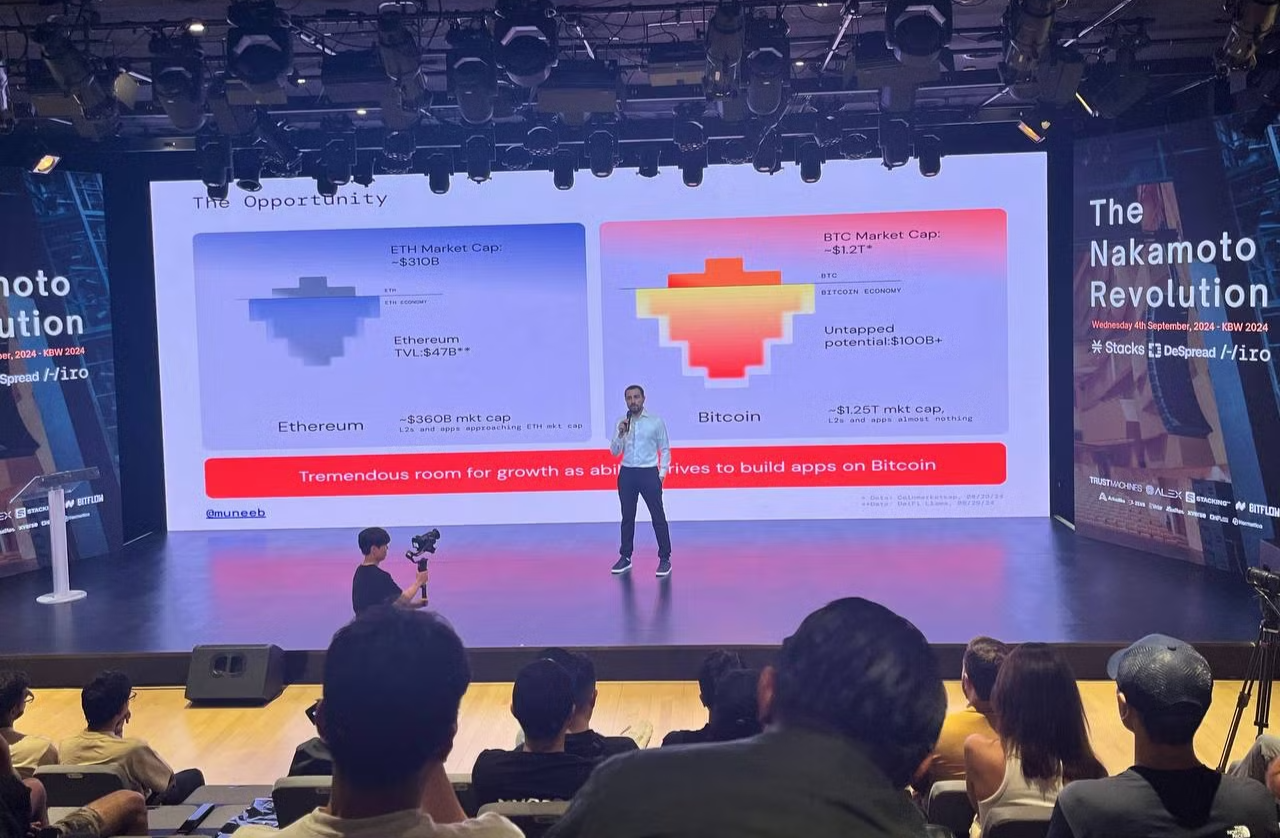
Recently, with the additional emergence of protocols such as the Babylon protocol, which provides security to other proof-of-stake networks using BTC as collateral, Bitcoin-based L2 networks, and protocols based on the Bitcoin network like Runes, cases of directly or indirectly utilizing Bitcoin are increasing.
Seeing these protocols actively participating in KBW2024's main event and side events, giving presentations and panel talks about the Bitcoin ecosystem, I could feel that the time is not far off when the Bitcoin ecosystem will be activated and Bitcoin will be actively used as collateral or payment assets in various ecosystems.
3.2. The Revival of DeFi through AI
I recently conducted research and wrote an article about the phenomenon of AI being incorporated into the DeFi ecosystem. And by participating in this event, I was able to confirm that a lot of development and discussion on this topic is actually taking place.
Scott Stuart, founder of Kava Network, the main event sponsor, gave a keynote speech "DeFi Meets AI" about the synergy between Kava AI, a decentralized AI being developed on their own network, and Kava's DeFi ecosystem. Also, Rune Christensen, founder of Sky (formerly MakerDAO), mentioned in an interview with Bloombit during KBW2024 that DeFi could achieve mass adoption through AI, showing an optimistic attitude towards the incorporation of AI into DeFi.
Like this, recently, beyond using blockchain as infrastructure to complement the limitations of the AI industry, attempts and related mentions to utilize AI in the blockchain ecosystem are actually increasing. Through this, I became convinced that more cases of DeFi protocols adopting AI will appear soon.
When AI is introduced to the DeFi ecosystem, anyone can easily use DeFi protocols without a high level of financial knowledge, which can greatly enhance the liquidity of the on-chain ecosystem. Therefore, I think AI holds the key to reviving the recently relatively stagnant DeFi ecosystem, and we need to closely watch the future development process of the DeFi ecosystem with AI incorporated.
3.3. Time to Focus on Applications Rather Than Infrastructure
While discussions on network infrastructure and technology dominated this KBW2024, discussions on actual use cases and applications of blockchain were relatively lacking. In particular, I got the impression that most of the discussions related to network infrastructure were on topics that were difficult for the general public without basic knowledge of blockchain to understand or empathize with. As the blockchain industry is still in transition, it shows a tendency to focus more on 'infrastructure' such as technology and networks rather than 'applications' that users actually use.
Networks equipped with advanced infrastructure are constantly being born, but there is a lack of applications that users can actually use beyond short-term incentives on these networks. As a result, the phenomenon of most users leaving the network after the completion of the airdrop campaign for user attraction by new networks is occurring.
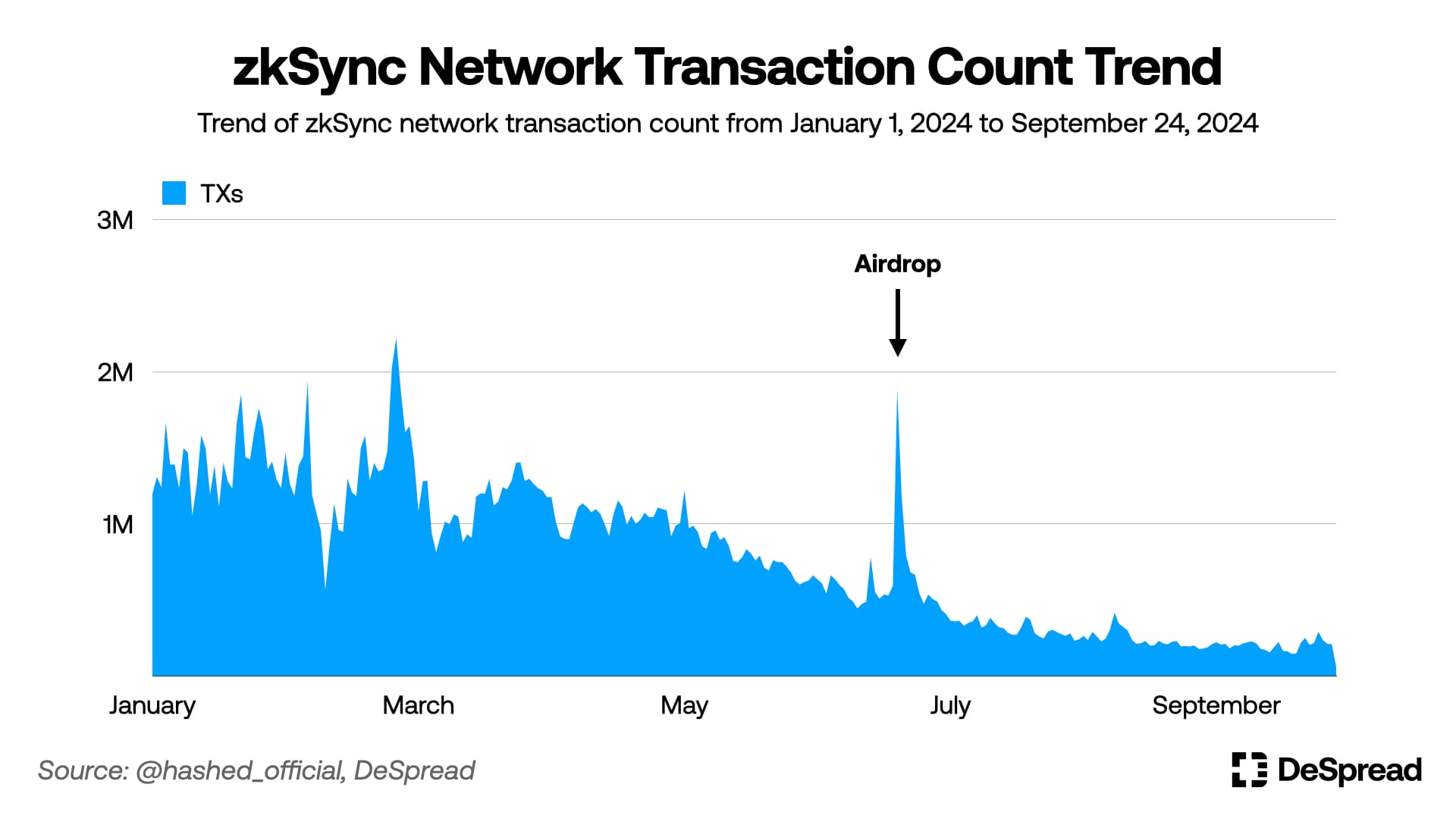
The development of technology and infrastructure is important, and the stance of market participants pursuing short-term incentives is not wrong either. However, I hope that more success stories of building network effects based on practical applications and achieving sustainable growth will emerge and gain attention in the future. Furthermore, I hope that through this, the blockchain industry will break away from the public perception of being merely a field for 'investment' or 'speculation', and be recognized as an industry with clear market fit in the near future.
4. Conclusion
This year's KBW2024: IMPACT attracted about twice as many foreign visitors compared to last year's event. While the overall popularity of global blockchain conferences has increased due to the bullish market trend, I could also feel that foreign project teams' interest in the Korean market has increased more than before through the speeches of overseas project teams.
At this event, we were able to look at infrastructure-related topics currently attracting attention in the market, and also confirm the hot interest in the Bitcoin ecosystem and AI. Additionally, we were able to have valuable time to directly listen to and greet people like Smokey The Bera of Berachain, whose news we could only access on Twitter before.
Moreover, the participation of major Korean institutions such as Hana Financial Group, SK Telecom, and Mirae Asset in the blockchain conference was impressive. However, it was regrettable that in Korea, as the process of organizing systems and regulations related to virtual assets is still ongoing, it is difficult for institutions to actively enter the market.
I hope that a stable institutional foundation will be established in Korea soon, and that we will be able to see more active participation from Korean institutions and Korea-based projects at next year's KBW2025.